Noble Gas Mass Spectrometry is used to study the isotopic composition of the noble gas group of elements – helium (He), argon (Ar), krypton (Kr), neon (Ne), xenon (Xe). They can be used for dating e.g. Argon isotopes, or as isotopic tracers in earth and cosmochemical evolution. The NGX-600 mass spectrometer from Isotopx is the latest version of this type of mass spectrometer. It features advanced multicollector technology (developed on the Isotopx, Phoenix Thermal Ionization Mass Spectrometer) in combination with a low volume, high sensitivity, high mass resolution spectrometer design. The objective is to provide a powerful, versatile, sensitive, noble gas mass spectrometer that is intuitive to use, which can also be customised for the most exacting applications.
NGX-600 Noble Gas Mass Spectrometer
The NGX-600 is a fully automated, high precision mass spectrometer with full multicollection capability for the measurement of noble gas isotope ratios at high resolution. It features a NEW high sensitivity ‘Nier’ type gas source and a low volume static vacuum analyser. The detector array may be populated with a customisable combination of Faraday cups and ion counting electron multipliers. The NGX is fitted with the new ATONA amplifiers as standard.
NGX-600 Design Features
- Compact design.
- Large radius magnet for optimal transmission, resolution and stability.
- Rotated ion focal plane such that the collector focal plane is perpendicular to the ion trajectory, ensuring optimal peak flat irrespective of collector position across the focal plane .
- NEW electronically calibrated ATONA amplifiers on all Faraday cups.
- Low volume design.
- NEW High Sensitivity Source.
- High resolution with capability to resolve organic interferences and 3 He from the HD and 20Ne from doubly charged 40Ar.
- Full multicollection capability with optional ability to measure all nine isotopes of xenon with full coincidence.
New Developments
The ultimate precision of isotope ratio mass spectrometry is governed by the signal/noise ratio of a measurement. This is of particular significance in applications of static vacuum noble gas mass spectrometry where sample size is often limited and thus, the signal size is constrained by the sensitivity of the source. Isotopx has successfully managed to improve this signal/noise performance on the NGX with 2 new developments. Firstly, improving the sensitivity of the source and secondly, reducing the noise on the Faraday amplifier detectors.
NEW High Sensitivity SOURCE
Isotopx has developed a new Nier-type source that offers unique sensitivity performance without compromising the lifetime of a filament. Operating at 1/10th of the electrical power of traditional sources, the temperature of the source runs much lower so interfering hydrocarbon volatile species are less prevalent in the vacuum. Our new source can comfortably achieve sensitivities of 7mA/Torr which is 7 times the specification of standard sources, whilst maintaining comparable filament lifetimes. Furthermore, as this performance is attained at lower emission temperatures, measured mass 36 backgrounds of 8E-15 ccSTP show a six-fold improvement on the standard specification.
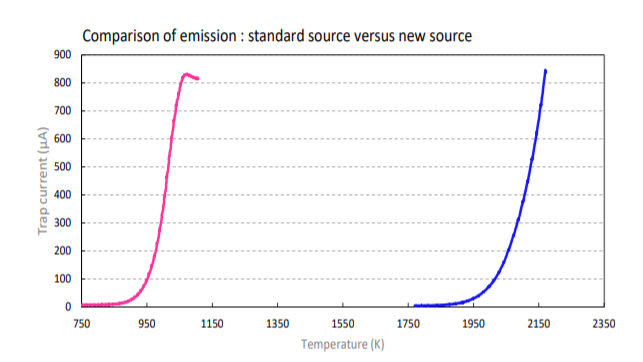
Low Temperature
The new NGX source operates at much lower temperatures than the standard source. This helps to reduce the formation of volatile interference species associated with higher temperature sources.
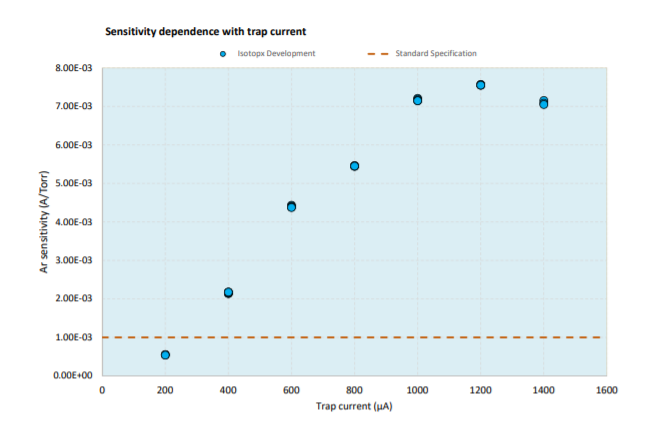
High Sensitivity
The new NGX source produces greater abundance if ionising electrons which means sensitivities can be increased by a factor of 5 compared to standard sources.
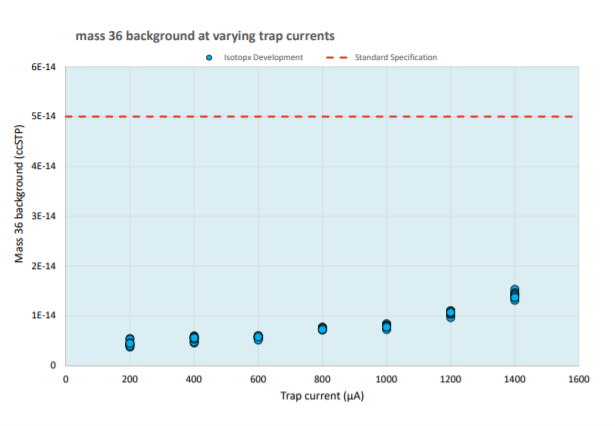
Low Backgrounds
Whilst the new NGX source offers increased source sensitivities, it does not increase the abundance of interfering background species.
NEW Faraday Amplifier ATONA®
The newly developed ATONA® (aA to nA) amplification technology from Isotopx has eliminated the need for a “feedback resistor”. The outcome is a significant reduction in amplifier noise, a dramatic increase in dynamic range, rapid amplifier decay, and improved baseline and calibration stability.
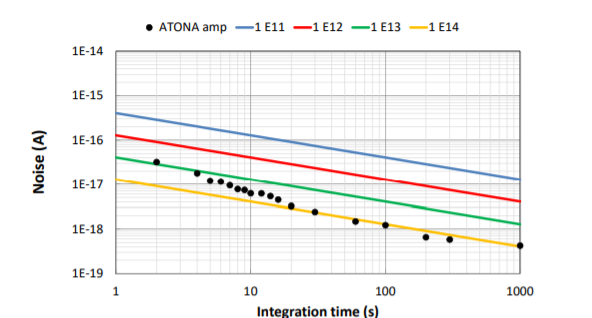
Noise
The ATONA® amplifier exhibits noise levels equivalent to a 1e13Ω resistor at short integration times, but behaves equivalent to 1e14Ω resistor at integration times greater than 20 seconds.
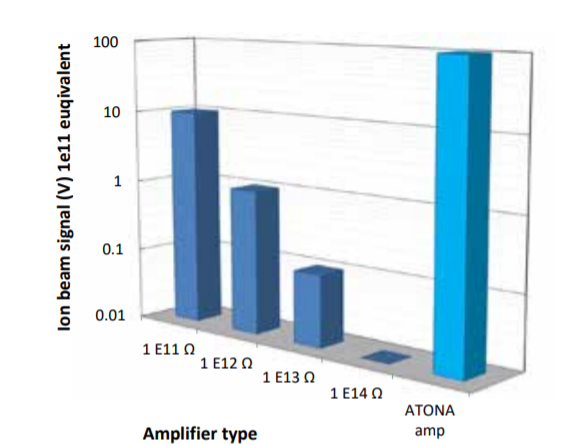
Range
Whilst the ATONA® amplifier exhibits low noise levels, it does not compromise the maximum signal size available to be measured. Ion beams of upto 100V (1nA) can be measured without saturating the amplifiers which can be the case with resistor amplifier technologies.
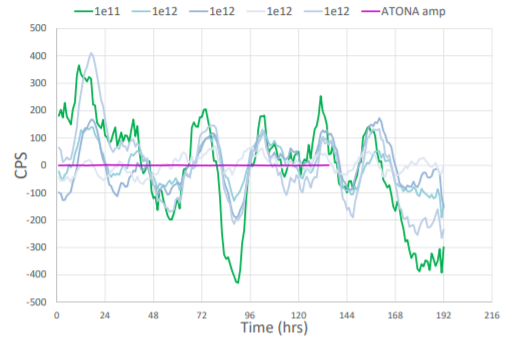
Baseline Stability
The ATONA® amplifier exhibits extremely stable baseline measurements over extended periods of time. This plot compares the ATONA® amplifier baseline stability against the existing resistor amplifier technologies over a period of 5 days.
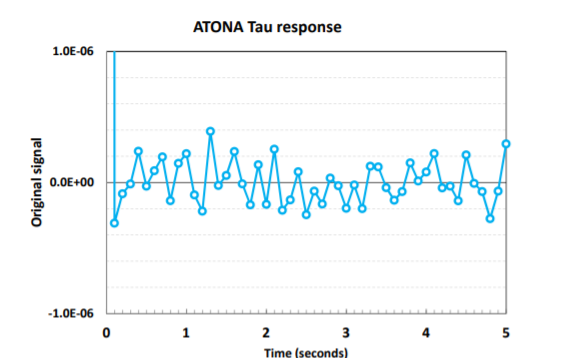
Tau Response
A limitiation of resistor amplifier technologies is the ability to return to baseline after on peak measurements. This is particularly problematic with higher gain amplifiers. However, the ATONA® amplifier exhibits no such delayed TAU response and returns to within 1ppm of baseline within 100ms.
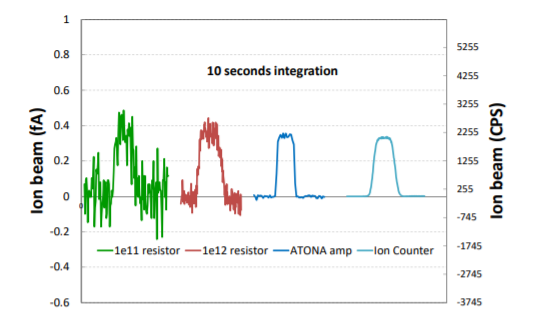
Detector Comparison
The plot to the left displays the peak shape of the sime sized ion beam scanned using different detector technologies. It can be seen that the ATONA® amplifier peak, with its low noise performance, appears more similar to that of the ion counting technology than the traditional resistor technology.
Full Multicollection Capability
The ion optics of the NGX-600 are based on the same magnet design as the Phoenix Thermal Ionization Mass Spectrometer. A large 90 degree 27cm radius magnet. The large radius magnet provides sufficient mass dispersion to allow for the static multicollection of Xe, Kr, Ne and Ar isotopes. Modified magnet exit poles rotate the focal plane of the instrument such that the collector focal plane is perpendicular to the ion trajectory, ensuring optimal peak flat irrespective of collector position across the focal plane. This allows full multicollection capability of the noble gas isotopes including an option to measure up to 9 isotopes of Xe simultaneously on Faraday collectors. This capability is unique to the NGX-600.
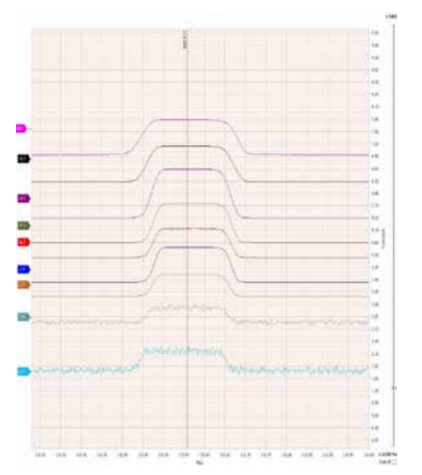

NGX Collection
The NGX-600 offers versatility whereby the configuration of both the number and type of detector is governed by the end user and their particular application. The collector array can be configured with multiple detector modules. Each detector module can be either a Faraday cup or an ion counting discrete dynode multiplier. The most common application is for Ar dating where the collectors are positioned to coincide with the 5 applicable argon isotopes, using a combination of Faraday cups and ion counters.
The Faraday cups are used in conjunction with the new Isotopx ATONA amplifier electronics. This new development offers unprecedented dynamic range, amplifier noise and ‘Tau’ response performance. The ATONA amplifiers can be electronically inter-calibrated and are housed within an evacuated and temperature controlled enclosure. The ion counting detectors use compact discrete dynode Secondary Electron Multipliers (SEM) and have typical efficiencies of ~90% with dark noise <10cpm.
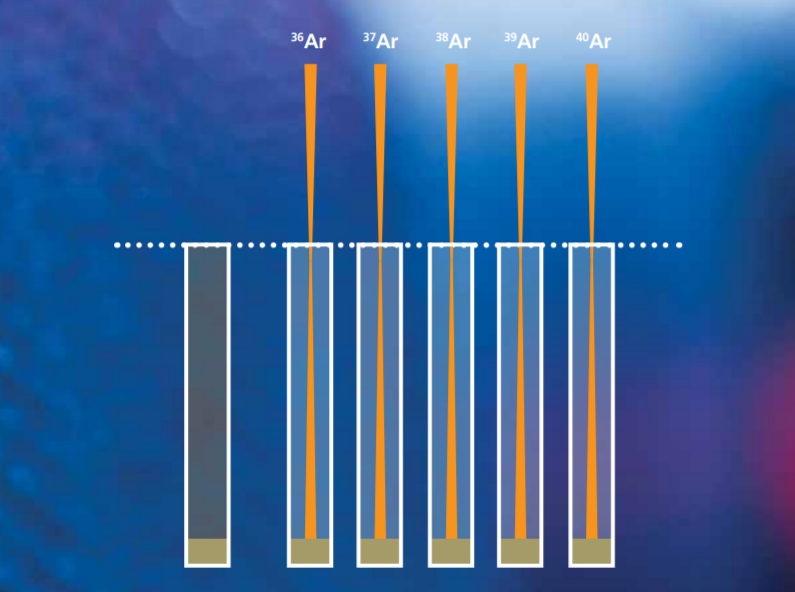
High Resolution
Interferences from hydrocarbons and other species can limit the accuracy of analysis in noble gas mass spectrometry. The base resolution of the NGX-600 is >600 at 10% valley with 100% ion transmission offering full sensitivity with a 0.25mm ion beam width at the source. This resolution is sufficient to resolve hydrocarbons and many other interfering species from the centre of the peaks of interest. The mass dispersion of the large radius magnet is also sufficient to allow for static multicollection of Xe, Kr, Ne and Ar at this resolution.
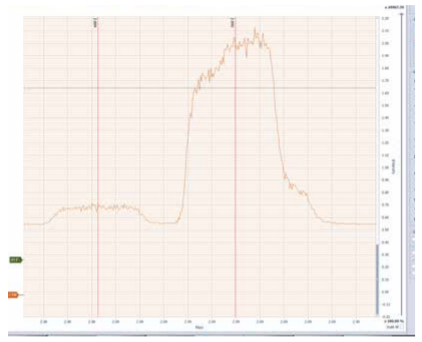
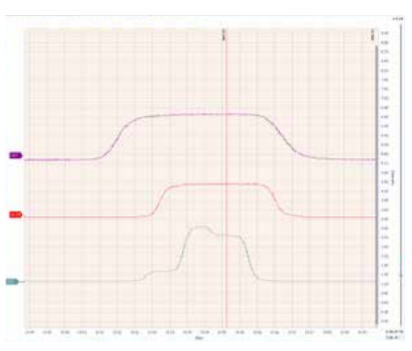
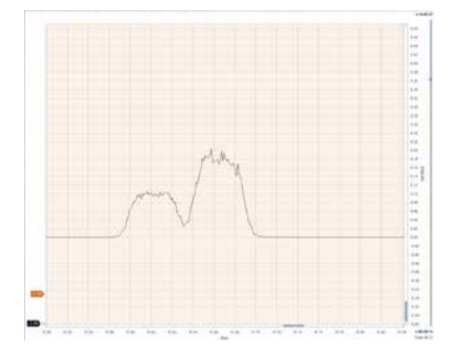
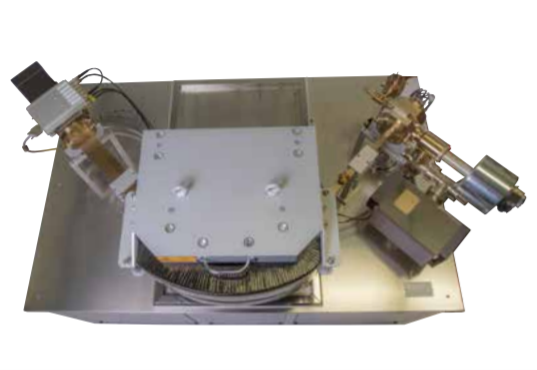
High Precision Analysis
The NGX-600 is the only noble gas mass spectrometer to combine multicollection, high resolution and high sensitivity in a single compact instrument.
This inherent design combination provides analyses of the highest precision.
Stability of Air Shots
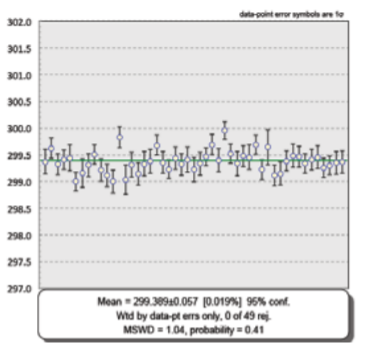
Linearity
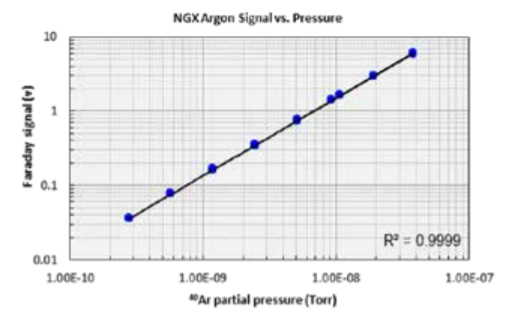
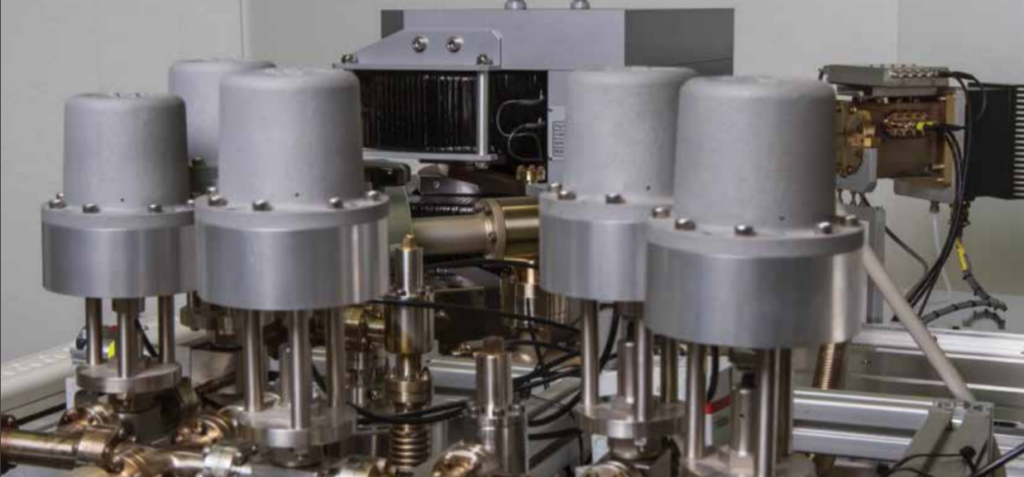
Preparation System and Accessories
Isotopx provides a gas purification line that allows full, automated clean-up of all noble gases and separation if required, prior to analysis with the NGX mass spectrometer. Using UHV techniques and knowledge amassed over many years of experience, Isotopx is able to provide a low volume extraction line to suit any particular application.
The gas purification line comprises a 80l/s turbomolecular pump backed with a dry diaphragm pump for instances that require the removal of high gas loads, coupled with a 40l/s ion for clean pumping applications.
A pair of GP50 SAES getters (St101 alloy), each supplied with their own power supply to maintain a constant operating temperature in order to target particular gas species.
As standard, the prep bench comes with a 0.2cc pipette in combination with a 4,000cc reservoir tank, which allows ability to prepare and admit air standards or spike aliquots.
A cold finger is provided with ~1cc of activated charcoal which if cooled with liquid nitrogen has the ability to trap all the heavy noble gases. Optionally, a cryotrap (8K-450K) can be considered for a more rigorous separation technique isolating individual gas species.
Valves are automated where necessary to allow for full automation of pre-analysis sample preparation and post-analysis clean up.
Vacuum assembly uses “off-the-shelf” vacuum components, which are readily available and allow for ease of expansion. All components are fully bakeable to 250o C using heater tapes provided. An ion gauge is provided to monitor pressure levels and vacuum integrity. Dynamic pressure levels are typically <1e9mBar. Blank ports facilitate flexibility providing the ability for future expansions or upgrades.
Optional additional accessories include an RGA quadrupole which can be used as a gas sampler or leak checker, a resistance furnace or a laser ablation or laser fusion system.

Software
The NGX has been designed for fully automated operation. All system parameters are controlled via the PC including all pneumatic isolation and inlet valves, source tuning parameters, magnetic current of the analyser and detector selection. Furthermore, instrument monitors are displayed through the software including ion gauge and ion pump readbacks, turbo pump speed and temperature, valve status and all source tuning parameters.The new NGX software is optimised to make full use of the instrument’s leading-edge electronics. Operating under Windows® 10 it provides dedicated data acquisition, control, error reporting & data processing.
The NGX software includes the following features:-
- Real-time display of source parameters, system vacuum status and collector readings.
- Advanced charting tools for easy visual analysis of collector intensities in mass scanning and intensity tuning modes.
- Includes mass and intensity markers, history scans, user annotations capabilities etc.
- Provides calibration & profiling tools, e.g. peak resolution, mass resolving power, source consumption, amplifier gain calibration etc.
- Allows easy access to all system parameters for manual control.
- Provides a time stamped log forming a record of all system activity.
- Exporting of raw data in various third-party formats.
- Comprehensive analysis method editor and reporting tools.
- Support for external inlet and furnace systems.
- Remote Control Server (RCS) which allows the end user to communicate to the NGX using TCP/IP protocol via other software programs or languages e.g. Labview, Pascal, C, C++, ArArCalc, Pychron, MassSpec
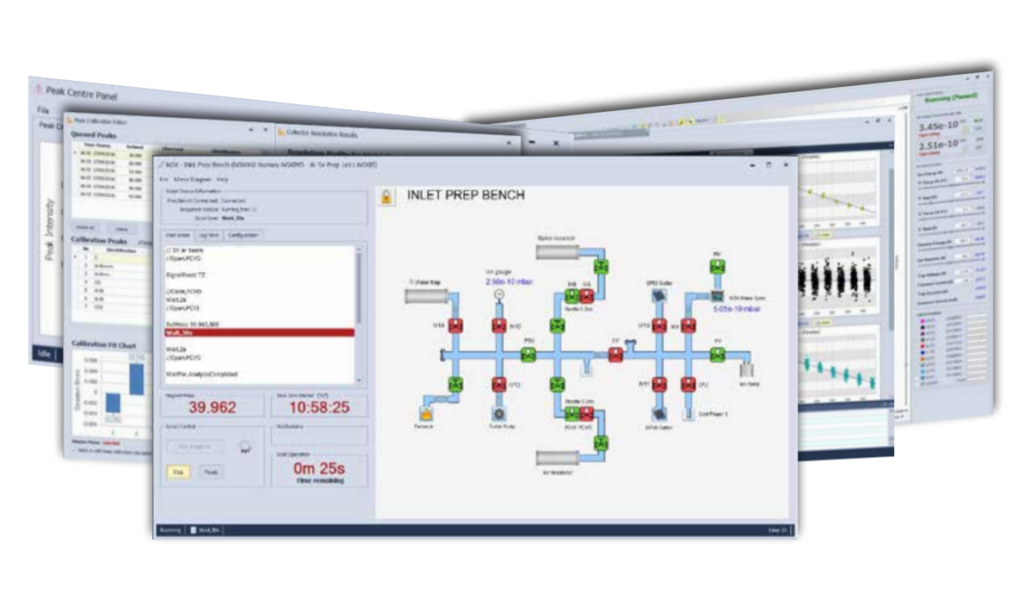
Download Product Information
Download the complete Product Information: NGX-600 Product Information